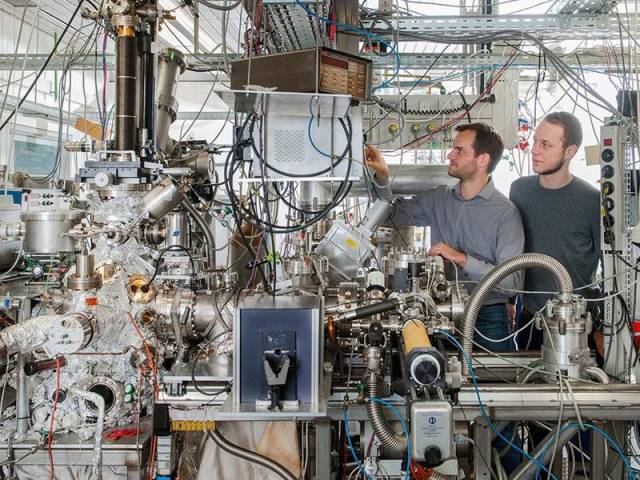Jan 29 2016
When margarine is produced, several tons of unsaturated fatty acids are converted from vegetable oils using hydrogen. When looking for improved catalysts for such hydrogenation reactions, a German-American research group discovered an effect that puts a 50-year old theory in question: In catalytic particles consisting of only a small number of atoms, size and shape affect reactivity more significantly than previously suggested.
 Andrew Crampton and Marian Rötzer at their vacuum chamber for production of ultra-small catalyst particles - Photo: Andreas Heddergott / TUM
Andrew Crampton and Marian Rötzer at their vacuum chamber for production of ultra-small catalyst particles - Photo: Andreas Heddergott / TUM
Tons of margarine are annually produced by converting vegetable oils in to unsaturated fatty acids using hydrogen. While hydrogenation of vegetable oils is carried out using cost-effective nickel catalysts, other reactions need expensive platinum.
As the hydrogenation reaction occurs only on the surface, with the inner atoms having no role, the industry is developing even smaller catalytic particles. The smallest atoms consist of a little more than 100 atoms. In smaller particles, quantum-mechanical effects take over, and conventional models are not successful in determining the properties of the platinum particles.
A group of researchers at the Technical University of Munich (TUM) and the Georgia Institute of Technology in Atlanta (Georgia) investigated such effects with a high-degree of precision. The group utilized the platinum catalyzed reaction, which converts ethene to ethane, as a model. Similar to unsaturated fatty acids, ethene has a carbon double bond. When two hydrogen atoms react with the bond, ethene becomes "saturated" ethane.
For more than 50 years scientists have divided catalytic reactions into ones affected by the size and structure of a catalyst, and those where these factors have no role.
The ethene hydrogenation was considered a typical example of a size-independent reaction. But our assumption was that this differentiation no longer applies to catalyst particles in the sub-nanometer range.
Ulrich Heiz, Chair of the Department of Physical Chemistry, TU Munich
The working group of Heiz generated platinum particles with a small number of atoms.
With our facility we can specifically produce platinum clusters having one to 80 platinum atoms
Andrew S. Crampton, Member of the Working Group
In the presence of the platinum particles, the group allowed ethene to react with hydrogen, and analyzed the results.
The reactivity is depends strongly on the exact number of atoms: clusters with less than ten atoms were barely active, while those with at least ten atoms demonstrated increasing reactivity, with the maximum reactivity being seen at 13 atoms. These particles have much higher reaction rates compared to a normal platinum surface, proving that the size-independency postulated for this reaction previously is not accurate.
Theoretical models provided by the American colleagues validate the experimental results. They allow exact determination of which atoms are responsible for which activity and why/
Such small clusters no longer behave as metal bodies, but rather as molecules: Small is different. The properties depend very clearly on the number of atoms.
Uzi Landman, Professor, Center for Computational Materials Science, Georgia Institute of Technology
Similar to popular game of Tangram, atoms of small clusters may arrange themselves in varying forms, referred to as isomers. In clusters consisting of a small number of atoms, interactions with the substrate atoms have a vital role.
Meanwhile, the Munich researchers developed several processes for fixing small platinum groups onto substrates.
This allows us to prevent the small particles from combining into larger ones. The surface, in turn, influences the predominantly assumed shape of the clusters. Together with the cluster size, we thus have an instrument for customizing the properties for a specific reaction.
Ulrich Heiz, Chair of the Department of Physical Chemistry, TU Munich
Working with the members of TUM’s Catalyst Research Center, the researchers are shortly going to develop wet chemical processes for efficiently producing small platinum clusters, which will have exact numbers of atoms in larger quantities.
The work received support from the European Research Council (ERC), the US Air Force Office for Scientific Research (AFOSR), and the Office of Basic Energy Sciences of the US Department of Energy (DOE).